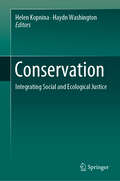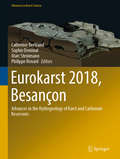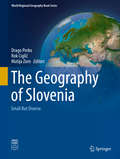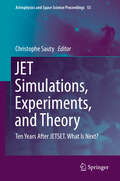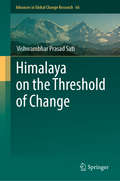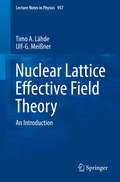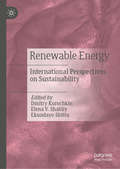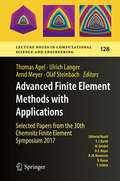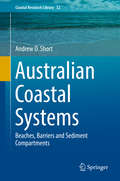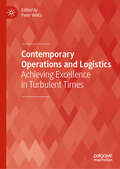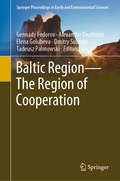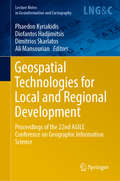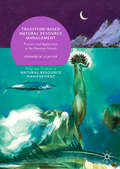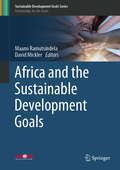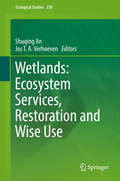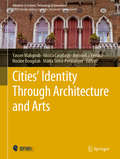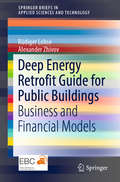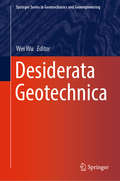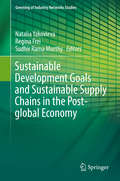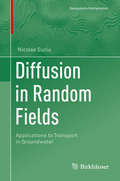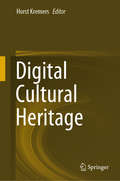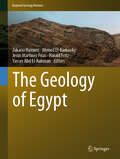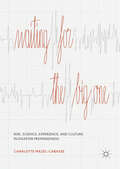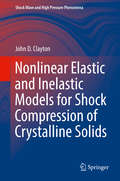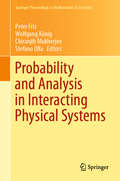- Table View
- List View
Conservation: Integrating Social and Ecological Justice (Routledge Explorations In Environmental Studies)
by Helen Kopnina Haydn WashingtonThis book provides keys to decrypt current political debates on the environment in light of the theories that support them, and provides tools to better understand and manage environmental conflicts and promote environmentally friendly behaviour. As we work towards global sustainability at a time when efforts to conserve biodiversity and combat climate change correspond with land grabs by large corporations, food insecurity, and human displacement. While we seek to reconcile more-than-human relations and responsibilities in the Anthropocene, we also struggle to accommodate social justice and the increasingly global desire for economic development. These and other challenges fundamentally alter the way social scientists relate to communities and the environment. This book takes as its point of departure today’s pressing environmental challenges, particularly the loss of biodiversity, and the role of communities in protected areas conservation. In its chapters, the authors discuss areas of tension between local livelihoods and international conservation efforts, between local communities and wildlife, and finally between traditional ways of living and ‘modernity’. The central premise of this book is while these tensions cannot be easily resolved they can be better understood by considering both social and ecological effects, in equal measure. While environmental problems cannot be seen as purely ecological because they always involve people, who bring to the environmental table their different assumptions about nature and culture, so are social problems connected to environmental constraints. While nonhumans cannot verbally bring anything to this negotiating table, aside from vast material benefits that society relies on, the distinct perspective of this book is that there is a need to consider the role of nonhumans as equally important stakeholders – albeit without a voice. This book develops an argument that human-environmental relationships are set within ecological reality and ecological ethics and rather than being mutually constitutive processes, humans have obligate dependence on nature, not vice versa. This would enable an ethical position encompassing the needs of other species and giving simultaneous (without one being subordinated to another) consideration to justice for humans and non-humans alike. The book is accessible to both social scientists and conservation specialists, and intends to contribute to strengthening interdisciplinary collaborations in the field of conservation.
Eurokarst 2018, Besançon: Advances in the Hydrogeology of Karst and Carbonate Reservoirs (Advances in Karst Science)
by Catherine Bertrand Sophie Denimal Marc Steinmann Philippe RenardThis book presents selected papers from the EuroKarst 2018 conference, which highlighted the latest advances in the field of Karst Hydrogeology and Carbonate Reservoirs. The event attracted more than 180 participants. From among their contributions, the papers were selected and subsequently reviewed by the scientific committee to ensure the highest possible quality.
The Geography of Slovenia: Small But Diverse (World Regional Geography Book Series)
by Drago Perko Rok Ciglič Matija ZornThis book is the first to give a comprehensive and detailed overview of the complete geography of Slovenia in English. Only very few countries, even considerably larger ones, can boast the landscape diversity found in Slovenia since the Alps, the Pannonian Basin, the Dinaric Alps, and the Mediterranean meet and interweave in this small corner of Central Europe, as do Germanic, Hungarian, Slavic, and Romance cultural influences. The book provides a systematical overview of physical and human geographical elements of Slovenia from landforms to cultural characteristics. Special attention is given to landscape diversity, to the presentation of Slovene landscape types and regions, to some particularities and interesting facts of Slovenia, and to the position of Slovenia in the World. The book also illustrates some other important geographical phenomena, processes and interactions between nature and society in nowadays Slovenia. This volume appeals to researchers as well as students in the field of regional geography. It can also serve as a source for complete background information as well as a field guide for Slovenia.
JET Simulations, Experiments, and Theory: Ten Years After JETSET. What Is Next? (Astrophysics and Space Science Proceedings #55)
by Christophe SautyIn 2008, the European FP6 JETSET project ended. JETSET, for Jet, Simulations, Experiments, and Theory, was a joint research network of European expert teams on protostellar jets. The present proceedings are a collection of contributions presenting new results obtained by those groups since the end of the JETSET program. This is also the occasion to celebrate Kanaris Tsinganos’ important contributions to this network and for his enlightening insight in the subject that inspired us all. Some of the former JETSET students are now in the academic world and the subject has never been so alive. So we present here a collection of results of what has been done in the field of protostellar jets in the past ten years from the theoretical, numerical, observational and experimental point of view. We also present new challenges in the field of protostellar jets and what we should expect from the development of new instruments and new numerical codes in the near future. We also gather results on the impact of the study of protostellar jets on other jet studies in particular on relativistic jets. As a matter of fact, it is time for a new network.
Himalaya on the Threshold of Change (Advances in Global Change Research #66)
by Vishwambhar Prasad SatiThis book provides a unique and comprehensive assessment of the changes that have been taking place in the Himalayas. It describes in detail all the aspects of change, both natural and cultural, along with their implications, and suggests policy measures to help mitigate them. The book is divided into two major sections – on natural changes and cultural changes – and 11 chapters: an introduction, six addressing changes that concern natural aspects, and four exploring cultural changes and presenting the book’s conclusions. The content is based on a study conducted using a participatory observation/empirical method. Time series data from secondary sources is also included, helping to analyze the various changes. The findings are presented in the form of color graphs, models, maps, photographs, and tables. The book offers a valuable resource for policymakers, and will prove equally useful for all other stakeholders, e.g. researchers, students and development agents.
Nuclear Lattice Effective Field Theory: An Introduction (Lecture Notes in Physics #957)
by Timo A. Lähde Ulf-G. MeißnerThis primer begins with a brief introduction to the main ideas underlying Effective Field Theory (EFT) and describes how nuclear forces are obtained from first principles by introducing a Euclidean space-time lattice for chiral EFT. It subsequently develops the related technical aspects by addressing the two-nucleon problem on the lattice and clarifying how it fixes the numerical values of the low-energy constants of chiral EFT. In turn, the spherical wall method is introduced and used to show how improved lattice actions render higher-order corrections perturbative. The book also presents Monte Carlo algorithms used in actual calculations. In the last part of the book, the Euclidean time projection method is introduced and used to compute the ground-state properties of nuclei up to the mid-mass region. In this context, the construction of appropriate trial wave functions for the Euclidean time projection is discussed, as well as methods for determining the energies of the low-lying excitations and their spatial structure. In addition, the so-called adiabatic Hamiltonian, which allows nuclear reactions to be precisely calculated, is introduced using the example of alpha-alpha scattering. In closing, the book demonstrates how Nuclear Lattice EFT can be extended to studies of unphysical values of the fundamental parameters, using the triple-alpha process as a concrete example with implications for the anthropic view of the Universe. Nuclear Lattice Effective Field Theory offers a concise, self-contained, and introductory text suitable for self-study use by graduate students and newcomers to the field of modern computational techniques for atomic nuclei and nuclear reactions.
Renewable Energy: International Perspectives on Sustainability
by Dmitry Kurochkin Elena V. Shabliy Ekundayo ShittuThis book bringing together leading researchers in the field of renewable energy to discuss sustainability on a broad scale and to examine the status quo of renewable energy industry development in a global context. The volume starts with the European Union, then reviews current trends in the United States as well as the Middle East, Central Asia, and Latin America. It moves on to analyze the German transition to one hundred percent renewable energy economy and energy systems (Energiewende) with a climate protection plan and sustainable economic development; and continues on to examine the determinants of the adoption of sustainable solutions in Finland and discuss the renewable energy agenda in the European Union with the 17 Sustainable Development Goals at its core. Climate change has become one of the main global drivers for policy and this book discusses both it’s over all global development as well as spotlighting localized progress across multiple continents. Over one hundred and fifty countries have developing sustainable energy policies, tax incentives, and laws. China remains the leader in renewable energy generation; and countries including the United States, the UK, India, Spain, and Turkey, compete in the Renewable Energy Sector to attract investments. In 2018, global investments in renewables exceeded $200 billion. The state of Bahia in Brazil has been experiencing a surge in wind energy production; and public policy has had a positive effect on that expansion. Kazakhstan is a country with great renewable energy prospects, particularly in wind, hydropower plants, and solar energy. This book is a comprehensive overview and invaluable reference for all those in the renewable energy sector.
Advanced Finite Element Methods with Applications: Selected Papers from the 30th Chemnitz Finite Element Symposium 2017 (Lecture Notes in Computational Science and Engineering #128)
by Ulrich Langer Thomas Apel Arnd Meyer Olaf SteinbachFinite element methods are the most popular methods for solving partial differential equations numerically, and despite having a history of more than 50 years, there is still active research on their analysis, application and extension. This book features overview papers and original research articles from participants of the 30th Chemnitz Finite Element Symposium, which itself has a 40-year history. Covering topics including numerical methods for equations with fractional partial derivatives; isogeometric analysis and other novel discretization methods, like space-time finite elements and boundary elements; analysis of a posteriori error estimates and adaptive methods; enhancement of efficient solvers of the resulting systems of equations, discretization methods for partial differential equations on surfaces; and methods adapted to applications in solid and fluid mechanics, it offers readers insights into the latest results.
Australian Coastal Systems: Beaches, Barriers and Sediment Compartments (Coastal Research Library #32)
by Andrew D. ShortThis book describes the entire coast and beaches and barrier systems of Australia. It covers the coastal processes and systems that form and impact Australia's 30.000 km coast, 12.000 beaches and 2750 barrier systems. These processes include geology, geomorphology, climate, waves, tides, currents, sediment supply, as well as coastal ecosystems. The coast is divided into tropical northern and southern temperate provinces, within which are seven divisions, 23 regions and 354 coastal sediment compartments each of which is described in detail in the 34 chapters. Within these systems are the full range of wave through tide-dominated beaches and barriers ranging from cheniers to massive transgressive dune systems together with a range of onshore and longshore sand transport systems. This is an up to date reference for the entire coast, its present condition and likely responses to the impacts of climate change.
Contemporary Operations and Logistics: Achieving Excellence in Turbulent Times
by Peter WellsThis edited collection collates the most up-to-date and important research within the area of operations and logistics management. Boasting the combined expertise of one of the largest logistics and operations management academic teams in Europe, it provides both depth and diversity in a balanced portfolio. The first two sections are concerned with key contemporary issues in the subject area, providing a current and up-to-date overview of the field. Section three presents a selection of important cross-cutting themes that impinge upon and inform teaching, research and practice, while the final section includes a celebration of research highlights and showcases cutting-edge applications from leaders in the field. Invaluable to students, researchers and academics alike, this book is compulsory reading for those active within operations and logistics research.
Baltic Region—The Region of Cooperation (Springer Proceedings in Earth and Environmental Sciences)
by Gennady Fedorov Alexander Druzhinin Elena Golubeva Dmitry Subetto Tadeusz PalmowskiThe Baltic macroregion is a platform for the development of different areas of international cooperation, which are an important factor affecting the socioeconomic growth of the region’s states. The deteriorating political relations between Russia and its Baltic neighbours complicate the development of mutual connections. However, economic and sociocultural cooperation and joint environmental projects continue despite all the difficulties. Based on recent studies carried out by Russian and Polish researchers, this book examines current trends in the socioeconomic development of the region’s countries and various forms of transboundary cooperation and provides recommendations for further development. Special attention is paid to sustainable environmental management and environmental protection, transboundary ties among companies and among people, the development of international tourism, opportunities for reinforcing the contact function of the border, and spatial planning. The book addresses theoretical problems that are of crucial significance to economic development and transboundary cooperation, namely, those of path dependence, the emerge.
Geospatial Technologies for Local and Regional Development: Proceedings of the 22nd AGILE Conference on Geographic Information Science (Lecture Notes in Geoinformation and Cartography)
by Ali Mansourian Phaedon Kyriakidis Diofantos Hadjimitsis Dimitrios SkarlatosThis book includes the full research papers accepted by the scientific programme committee for the 22nd AGILE Conference on Geographic Information Science, held in June 2019 at Cyprus University of Technology, Limassol, Cyprus. It is intended primarily for professionals and researchers in geographic information science, as well as those in related fields in which geoinformation application plays a significant role.
Tradition-Based Natural Resource Management: Practice and Application in the Hawaiian Islands (Palgrave Studies in Natural Resource Management)
by Edward W. GlazierThis book addresses the complex socio-political context of natural resource management in coastal and marine environments throughout the contemporary Pacific Islands and provides lessons that can be applied around the globe. The author spotlights one particular case in which Native Hawaiians worked successfully to develop a formal policy mechanism through which to advise government agencies in the State of Hawaii on matters regarding traditional and customary use and management of the island’s natural resources. Glazier describes historic-traditional aspects of natural resource use and management in the Hawaiian Islands and the challenging process that was employed to enhance the capacity of modern Hawaiians to influence the course of their future. This process successfully broached and addressed truly difficult challenges, including but not limited to: the convening of representatives of a complex society of indigenous persons in order to elicit traditional place-based knowledge and varying perspectives on the appropriate use and management of natural resources; the incorporation of such knowledge and perspectives into the modern natural resource management and policy context; and the need to balance the interests of indigenous persons and those of more recently-arriving persons around the island chain. The lessons learned were many and varied and are particularly germane for resource managers, scientists, policymakers, and indigenous persons seeking to undertake balanced natural resource policy decisions in island, coastal, and indigenous settings around the Pacific and beyond.
Africa and the Sustainable Development Goals (Sustainable Development Goals Series)
by Maano Ramutsindela David MicklerThe book draws upon the expertise and international research collaborations forged by the Worldwide Universities Network Global Africa Group to critically engage with the intersection, in theory and practice, of the Sustainable Development Goals (SDGs) and Africa’s development agendas and needs. Further, it argues that – and demonstrates how – the SDGs should be understood as an aspirational blueprint for development with multiple meanings that are situated in dynamic and contested terrains. As the SDGs have substantial implications for development policy and resourcing at both the macro and micro levels, their relevance is not only context-specific but should also be assessed in terms of the aspirations and needs of ordinary citizens across the continent. Drawing on analyses and evidence from both the natural and social sciences, the book demonstrates that progress towards the SDGs must meet demands for improving human well-being under diverse and challenging socio-economic, political and environmental conditions. Examples include those from the mining industry, public health, employment and the media. In closing, it highlights how international collaboration in the form of research networks can enhance the production of critical knowledge on and engagement with the SDGs in Africa.
Wetlands: Ecosystem Services, Restoration and Wise Use (Ecological Studies #238)
by Shuqing An Jos T. A. VerhoevenThis volume explores major wetland ecosystem services, such as climate cooling and water quality improvement, and discusses the recent wetland conservation and restoration activities in China and neighboring countries. The role of wetlands in either cooling or warming the climate is analyzed as the net balance between carbon sequestration and emissions of methane and nitrous oxide. Wetlands start off having a net warming effect on the climate but in time switch to net cooling. Further, they remove 40% of the N and P from run-off and groundwater flow in agricultural areas, but wetlands need to amount to 10% of the total catchment area to make a difference.Reflecting on the recent large investment in wetland ecological studies in China and neighboring countries, the book addresses invasive species in coastal wetlands as well as the protection and wise use of tidal flats around the Yellow Sea. It also presents promising regional case studies on wetland restoration. The book is intended for academics, students and practitioners in the field of wetland ecology, management and restoration, as well as consultants and professionals working in conservation, wise use and environmental policy.
Cities' Identity Through Architecture and Arts: Proceedings Of The International Conference On Cities' Identity Through Architecture And Arts (citaa 2017), May 11-13, 2017, Cairo, Egypt (Advances in Science, Technology & Innovation)
by Yasser Mahgoub Nicola Cavalagli Antonella Versaci Hocine Bougdah Marta Serra-PermanyerThis book covers a broad range of topics relating to architecture and urban design, such as the conservation of cities’ culture and identity through design and planning processes, various ideologies and approaches to achieving more sustainable cities while retaining their identities, and strategies to help cities advertise themselves on the global market.Every city has its own unique identity, which is revealed through its physical and visual form. It is seen through the eyes of its inhabitants and visitors, and is where their collective memories are shaped. In turn, these factors affect tourism, education, culture & economic prosperity, in addition to other aspects, making a city’s identity one of its main assets.Cities’ identities are constructed and developed over time and are constantly evolving physically, culturally and sociologically. This book explains how architecture and the arts can embody the historical, cultural and economic characteristics of the city. It also demonstrates how cities’ memories play a vital role in preserving their physical and nonphysical heritage. Furthermore, it examines the transformation of cities and urban cultures, and investigates the various new approaches developed in contemporary arts and architecture.Given its scope, the book is a valuable resource for a variety of readers, including students, educators, researchers and practitioners in the fields of city planning, urban design, architecture and the arts.
Deep Energy Retrofit Guide for Public Buildings: Business and Financial Models (SpringerBriefs in Applied Sciences and Technology)
by Rüdiger Lohse Alexander ZhivovThis book provides detailed information on how to set up Deep Energy Retrofits (DERs) in public buildings, and shares in-depth insights into the current status of the major technologies, strategies and practical best practice examples of how to cost-effectively combine them. Case studies from Europe are analyzed with respect to energy use before and after renovation, reasons for undertaking the renovation, co-benefits achieved, resulting cost-effectiveness, and the business models employed. The building sector holds the potential for tremendous improvements in terms of energy efficiency and reducing carbon emissions, and energy retrofits to the existing building stock represent a significant opportunity in the transition to a low-carbon future. Moreover, investing in highly efficient building materials and systems can replace long-term energy imports, contribute to cost cutting, and create a wealth of new jobs. Yet, while the technologies needed in order to improve energy efficiency are readily available, significant progress has not yet been made, and “best practices” for implementing building technologies and renewable energy sources are still relegated to small “niche” applications. Offering essential information on Deep Energy Retrofits, the book offers a valuable asset for architects, public authorities, project developers, and engineers alike.
Desiderata Geotechnica (Springer Series in Geomechanics and Geoengineering)
by Wei WuThis book presents contributions to a workshop dedicated to Prof. Gerd Gudehus on the occasion of his 80th birthday and held in Vienna, Austria, on 14-16 August 2018. The articles gathered here, many of which were written by former students, friends and colleagues of Prof. Gudehus, cover diverse topics that reflect the breadth and depth of geomechanics research. Consequently, they offer a valuable source of ideas and inspiration on areas ranging from sophisticated constitutive models to advanced numerical methods, from particles to continua, and from fractals of geomaterials to the design of offshore wind turbine foundations.
Sustainable Development Goals and Sustainable Supply Chains in the Post-global Economy (Greening of Industry Networks Studies #7)
by Natalia Yakovleva Regina Frei Sudhir Rama MurthyThis book presents a collection of studies on current best practices for delivering sustainable development policies within supply chains. It critiques the limitations of existing business theory and practice on sustainable supply chain management, and discusses opportunities for new conceptual models for businesses to engage with Sustainable Development Goals (SDGs). It examines how businesses can work towards implementing Sustainable Development Goals in the contexts of entrepreneurial initiative, industry collaboration and regional development. SDGs renew the sustainable development agenda for global communities and ask businesses and organisations to reset their sustainable development policies. A strategy to embed sustainable development principles into business operations along the supply chain operations, which has been a conceptual and, in many instances, practitioner, business and industry achievement of the past decades, is not enough to shift the economic and social conditions of poor populations around the world. How would the global supply chains of the future look like? What social relations does it envisage? How will businesses and organisations engage with societies, environments and complex institutional contexts in emerging markets and developing countries, which are faced with issues of population growth, needed leaps in infrastructure provision, educational and health improvements, cultural and institutional shifts? The books challenges current approaches to sustainable supply chain practices guided by discussion on SDGs. It reviews implementation issues of existing sustainable development approaches, assesses the advancement of sustainable development strategies and examines the opportunities for global value chains to increase their positive social and environmental inputs in regions, communities and organisations. The book collects both conceptual and empirical studies set in a variety of business and organisational contexts, such as manufacturing, retail, procurement, cities and industrial parks. It contests the accepted axioms of sustainable practices in the global supply chains and proposes new models for organisations and production networks to engage with societies and address market and production effects on communities and institutions.
Diffusion in Random Fields: Applications to Transport in Groundwater (Geosystems Mathematics)
by Nicolae SuciuThis book presents, in an accessible and self-consistent way, the theory of diffusion in random velocity fields, together with robust numerical simulation approaches. The focus is on transport processes in natural porous media, with applications to contaminant transport in groundwater. Starting from basic information on stochastic processes, more challenging issues are subsequently addressed, such as the correlation structure of the diffusion process in random fields, the relation between memory effects and ergodic properties, derivation and parameterizations of evolution equations for probability densities, and the relation between measurements and spatio-temporal upscaling.Written for readers with a background in applied mathematics, engineering, physics or geophysics, the book offers an essential basis for further research in the stochastic modeling of groundwater systems.
Digital Cultural Heritage
by Horst KremersThis book provides an overview of various application spheres and supports further innovations needed in information management and in the processes of knowledge generation. The professions, organizations and scientific associations involved are unusually challenged by the complexity of the data situation. Cartography has always been the central field of application for georeferencing digital cultural heritage (DCH) objects. It is particularly important in enabling spatial relation analysis between any number of DCH objects or of their granular details. In addition to the pure geometric aspects, the cognitive relations that lead to knowledge representation and derivation of innovative use processes are also of increasing importance. Further, there is a societal demand for spatial reference and analytics (e.g. the extensive use of cognitive concepts of "map" and "atlas" for a variety of social topics in the media). There is a huge geometrical-logical-cognitive potential for complex, multimedia, digital-cultural-heritage databases and stakeholders expect handling, transmission and processing operations with guaranteed long-term availability for all other stakeholders. In the future, whole areas of digital multimedia databases will need to be processed to further our understanding of historical and cultural contexts. This is an important concern for the information society and presents significant challenges for cartography in all these domains.This book collects innovative technical and scientific work on the entire process of object digitization, including detail extraction, archiving and interoperability of multimedia DCH data.
The Geology of Egypt (Regional Geology Reviews)
by Zakaria Hamimi Ahmed El-Barkooky Jesús Martínez Frías Harald Fritz Yasser Abd El-RahmanThis richly illustrated book offers a concise overview of the geology of Egypt in the context of the geology of the Arab Region and Northeast Africa. An introductory chapter on history of geological research in Egypt sheds much light on the stages before and after the establishment of Egyptian Geological Survey (the second oldest geological survey worldwide), Hume's book and Said's 1962, 1990 books. The book starts with the Precambrian geology of Egypt, in terms of lithostratigraphy and classifications, structural and tectonic framework, crustal evolution and metamorphic belts. A dedicated chapter discusses the Paleozoic-Mesozoic-Cenozoic tectonics and structural evolution of Egypt. A chapter highlights the Red Sea tectonics and the Gulf of Suez and Gulf of Aqaba Rifts. Subsequent chapters address the Phanerozoic geology from Paleozoic to Quaternary. The Egyptian Impact Crater(s) and Meteorites are dealt with in a separate chapter. The Earth resources in Egypt, including metallic and non-metallic ore deposits, hydrocarbon and water resources, are given much more attention throughout four chapters. The last chapter addresses the seismicity, seismotectonics and neotectonics of Egypt.
Waiting for the Big One: Risk, Science, Experience, and Culture in Disaster Preparedness
by Charlotte Mazel-CabasseThis book helps understand how the future Big One (a large-scale and often-predicted earthquake) is understood, defined, and mitigated by experts, scientists, and residents in the San Francisco Bay Area. Following the idea that earthquake risk is multiple and hard to grasp, the book explores the earthquake’s “mode of existence,” guiding the reader through different epistemic moments of the earthquake-risk definition. Through in-depth interviews, the book provides a rarely seen anthropology of risk from the perspective of experts, scientists, and concerned residents for whom the possibility of partial or complete destruction of their living environment is a constant companion of their everyday lives. It argues that the characterization of the threats and the measures taken to limit its impacts constitute an integrated part of both their residential experiences and their professional practices.
Nonlinear Elastic and Inelastic Models for Shock Compression of Crystalline Solids (Shock Wave and High Pressure Phenomena)
by John D. ClaytonThis book describes thermoelastic and inelastic deformation processes in crystalline solids undergoing loading by shock compression. Constitutive models with a basis in geometrically nonlinear continuum mechanics supply these descriptions. Large deformations such as finite strains and rotations, are addressed. The book covers dominant mechanisms of nonlinear thermoelasticity, dislocation plasticity, deformation twinning, fracture, flow, and other structure changes. Rigorous derivations of theoretical results are provided, with approximately 1300 numbered equations and an extensive bibliography of over 500 historical and modern references spanning from the 1920s to the present day. Case studies contain property data, as well as analytical, and numerical solutions to shock compression problems for different materials. Such materials are metals, ceramics, and minerals, single crystalline and polycrystalline.The intended audience of this book is practicing scientists (physicists, engineers, materials scientists, and applied mathematicians) involved in advanced research on shock compression of solid materials.
Probability and Analysis in Interacting Physical Systems: In Honor of S.R.S. Varadhan, Berlin, August, 2016 (Springer Proceedings in Mathematics & Statistics #283)
by Peter Friz Wolfgang König Chiranjib Mukherjee Stefano OllaThis Festschrift on the occasion of the 75th birthday of S.R.S. Varadhan, one of the most influential researchers in probability of the last fifty years, grew out of a workshop held at the Technical University of Berlin, 15–19 August, 2016. This volume contains ten research articles authored by several of Varadhan's former PhD students or close collaborators. The topics of the contributions are more or less closely linked with some of Varadhan's deepest interests over the decades: large deviations, Markov processes, interacting particle systems, motions in random media and homogenization, reaction-diffusion equations, and directed last-passage percolation. The articles present original research on some of the most discussed current questions at the boundary between analysis and probability, with an impact on understanding phenomena in physics. This collection will be of great value to researchers with an interest in models of probability-based statistical mechanics.
